Modeling of and Experimenting with Concentric Tube Robots: Considering Clearance, Friction and Torsion
Abstract
:1. Introduction
- A new kinematic model of concentric tube robots based on the variable curvature assumption and the infinitesimal method is developed. The new model considers three effects on the tip position of CTRs: friction, torsion, and clearance. The model can predict the tip position accurately;
- The kinematic modeling process is simplified. Compared with the existing modeling methods that consider clearance, friction, and torsion, the new approach changes the order in which the three effects are modeled. The improved modeling is concise and allows for faster modeling;
- Forward kinematic experiments are designed to verify the accuracy of the improved model. These prove that the accuracy of the improved model is much higher than that of the previous one, which neglects clearance, torsion, and friction.
2. Problem Statement
3. Kinematic Model Considering the Frictional Clearance
3.1. Curvature Solution Considering Concentrated Frictional Moment
3.2. Clearance Analysis and Kinematic Modeling
4. Experimental Validation and Analysis of Results
4.1. Experimental Setup
4.2. Parameter Identification
4.3. Experiment with the Tip Position of the Feed Motion
4.4. Rotational Motion Tip Position Experiment
5. Conclusions and Future Work
Author Contributions
Funding
Institutional Review Board Statement
Informed Consent Statement
Data Availability Statement
Conflicts of Interest
References
- Bodner, J.; Wykypiel, H.; Wetscher, G.; Schmid, T. First experiences with the da Vinci™ operating robot in thoracic surgery. Eur. J. Cardio Thorac. Surg. 2004, 25, 844–851. [Google Scholar] [CrossRef] [PubMed] [Green Version]
- Hockstein, N.G.; Nolan, J.P.; O’Malley, B.W., Jr.; Woo, Y.J. Robotic microlaryngeal surgery: A technical feasibility study using the daVinci surgical robot and an airway mannequin. Laryngoscope 2005, 115, 780–785. [Google Scholar] [CrossRef] [PubMed] [Green Version]
- Kim, K.; Hagen, M.E.; Buffington, C. Robotics in advanced gastrointestinal surgery: The bariatric experience. Cancer J. 2013, 19, 177–182. [Google Scholar] [CrossRef] [PubMed]
- Maeso, S.; Reza, M.; Mayol, J.A.; Blasco, J.A.; Guerra, M.; Andradas, E.; Plana, M.N. Efficacy of the Da Vinci surgical system in abdominal surgery compared with that of laparoscopy: A systematic review and meta-analysis. Ann. Surg. 2010, 252, 254–262. [Google Scholar] [CrossRef] [PubMed]
- Haidegger, T.; Speidel, S.; Stoyanov, D.; Satava, R.M. Robot-assisted minimally invasive surgery—Surgical robotics in the data age. Proc. IEEE 2022, 110, 835–846. [Google Scholar] [CrossRef]
- Burgner-Kahrs, J.; Rucker, D.C.; Choset, H. Continuum robots for medical applications: A survey. IEEE Trans. Robot. 2015, 31, 1261–1280. [Google Scholar] [CrossRef]
- Dupont, P.E.; Simaan, N.; Choset, H.; Rucker, C. Continuum robots for medical interventions. Proc. IEEE 2022, 110, 847–870. [Google Scholar] [CrossRef]
- Rone, W.S.; Ben-Tzvi, P. Mechanics modeling of multisegment rod-driven continuum robots. J. Mech. Robot. 2014, 6, 041006. [Google Scholar] [CrossRef] [Green Version]
- Yuan, H.; Zhou, L.; Xu, W. A comprehensive static model of cable-driven multi-section continuum robots considering friction effect. Mech. Mach. Theory 2019, 135, 130–149. [Google Scholar] [CrossRef]
- Yeshmukhametov, A.; Koganezawa, K.; Yamamoto, Y. Design and kinematics of cable-driven continuum robot arm with universal joint backbone. In Proceedings of the 2018 IEEE International Conference on Robotics and Biomimetics (ROBIO), Kuala Lumpur, Malaysia, 12–15 December 2018; IEEE: Washington, DC, USA, 2018; pp. 2444s–2449s. [Google Scholar]
- Santiago, J.L.C.; Walker, I.D.; Godage, I.S. Continuum robots for space applications based on layer-jamming scales with stiffening capability. In Proceedings of the 2015 IEEE Aerospace Conference, Big Sky, MT, USA, 7–14 March 2015; IEEE: Washington, DC, USA, 2015; pp. 1–13. [Google Scholar]
- Yang, C.; Geng, S.; Walker, I.; Branson, D.T.; Liu, J.; Dai, J.S.; Kang, R. Geometric constraint-based modeling and analysis of a novel continuum robot with shape memory alloy initiated variable stiffness. Int. J. Robot. Res. 2020, 39, 1620–1634. [Google Scholar] [CrossRef]
- Elena, G. Novel design of a soft lightweight pneumatic continuum robot arm with decoupled variable stiffness and positioning. Soft Robot. 2018, 5, 54–70. [Google Scholar]
- Kang, B.-S.; Park, E.J. Modeling and control of an intrinsic continuum robot actuated by pneumatic artificial muscles. In Proceedings of the 2016 IEEE International Conference on Advanced Intelligent Mechatronics (AIM), Banff, AB, Canada, 12–15 July 2016; IEEE: Washington, DC, USA, 2016; pp. 1157–1162. [Google Scholar]
- Kang, R.; Guo, Y.; Chen, L.; Branson, D.T.; Dai, J.S. Design of a pneumatic muscle based continuum robot with embedded tendons. IEEE ASME Trans. Mechatron. 2016, 22, 751–761. [Google Scholar] [CrossRef] [Green Version]
- Sun, C.; Chen, L.; Liu, J.; Dai, J.S.; Kang, R. A hybrid continuum robot based on pneumatic muscles with embedded elastic rods. Proc. Inst. Mech. Eng. Part C J. Mech. Eng. Sci. 2020, 234, 318–328. [Google Scholar] [CrossRef]
- Zhang, G.; Du, F.; Xue, S.; Cheng, H.; Zhang, X.; Song, R.; Li, Y. Design and modeling of a bio-inspired compound continuum robot for minimally invasive surgery. Machines 2022, 10, 468. [Google Scholar] [CrossRef]
- Webster, R.J.; Romano, J.M.; Cowan, N.J. Mechanics of precurved-tube continuum robots. IEEE Trans. Robot. 2008, 25, 67–78. [Google Scholar] [CrossRef]
- Webster, R.J., III; Jones, B.A. Design and kinematic modeling of constant curvature continuum robots: A review. Int. J. Robot. Res. 2010, 29, 1661–1683. [Google Scholar] [CrossRef]
- Wang, J.; Yang, X.; Li, P.; Song, S.; Liu, L.; Meng, M.Q.-H. Design of a multi-arm concentric-tube robot system for transnasal surgery. Med. Biol. Eng. Comput. 2020, 58, 497–508. [Google Scholar] [CrossRef]
- Madoglio, A.; Zappa, F.; Mattavelli, D.; Rampinelli, V.; Ferrari, M.; Schreiber, A.; Belotti, F.; Villaret, A.B.; Tampalini, F.; Cassinis, R. Robotics in endoscopic transnasal skull base surgery: Literature review and personal experience. Control Syst. Des. Bio Robot. Bio Mechatron. Adv. Appl. 2020, 221–244. [Google Scholar]
- Mahoney, A.W.; Gilbert, H.B.; Webster, R.J., III. A review of concentric tube robots: Modeling, control, design, planning, and sensing. Encycl. Med. Robot. Vol. 1 Minim. Invasive Surg. Robot. 2019, 1, 181–202. [Google Scholar]
- Bergeles, C.; Gosline, A.H.; Vasilyev, N.V.; Codd, P.J.; Pedro, J.; Dupont, P.E. Concentric tube robot design and optimization based on task and anatomical constraints. IEEE Trans. Robot. 2015, 31, 67–84. [Google Scholar] [CrossRef] [Green Version]
- Swaney, P.J.; Gilbert, H.B.; Webster, R.J., III; Russell, P.T., III; Weaver, K.D. Endonasal skull base tumor removal using concentric tube continuum robots: A phantom study. J. Neurol. Surg. Part B Skull Base 2015, 76, 145–149. [Google Scholar]
- Swaney, P.J.; Mahoney, A.W.; Remirez, A.A.; Lamers, E.; Hartley, B.I.; Feins, R.H.; Alterovitz, R.; Webster, R.J. Tendons, concentric tubes, and a bevel tip: Three steerable robots in one transoral lung access system. In Proceedings of the 2015 IEEE International Conference on Robotics and Automation (ICRA), Washington, DC, USA, 26–30 May 2015; IEEE: Washington, DC, USA, 2015; pp. 5378–5383. [Google Scholar]
- Dupont, P.E.; Lock, J.; Butler, E. Torsional kinematic model for concentric tube robots. In Proceedings of the 2009 IEEE International Conference on Robotics and Automation, Kobe, Japan, 12–17 May 2009; IEEE: Washington, DC, USA, 2009; pp. 3851–3858. [Google Scholar]
- Dupont, P.E.; Lock, J.; Itkowitz, B.; Butler, E. Design and control of concentric-tube robots. IEEE Trans. Robot. 2009, 26, 209–225. [Google Scholar] [CrossRef] [Green Version]
- Ha, J.; Fagogenis, G.; Dupont, P.E. Modeling tube clearance and bounding the effect of friction in concentric tube robot kinematics. IEEE Trans. Robot. 2018, 35, 353–370. [Google Scholar] [CrossRef] [PubMed]
- Fichtinger, G.; Troccaz, J.; Haidegger, T. Image-guided interventional robotics: Lost in translation? Proc. IEEE 2022, 110, 932–950. [Google Scholar] [CrossRef]
- Lock, J.; Dupont, P.E. Friction modeling in concentric tube robots. In Proceedings of the 2011 IEEE International Conference on Robotics and Automation, Shanghai, China, 9–13 May 2011; IEEE: Washington, DC, USA, 2011; pp. 1139–1146. [Google Scholar]
- Sugihara, T. Solvability-unconcerned inverse kinematics by the Levenberg–Marquardt method. IEEE Trans. Robot. 2011, 27, 984–991. [Google Scholar] [CrossRef]
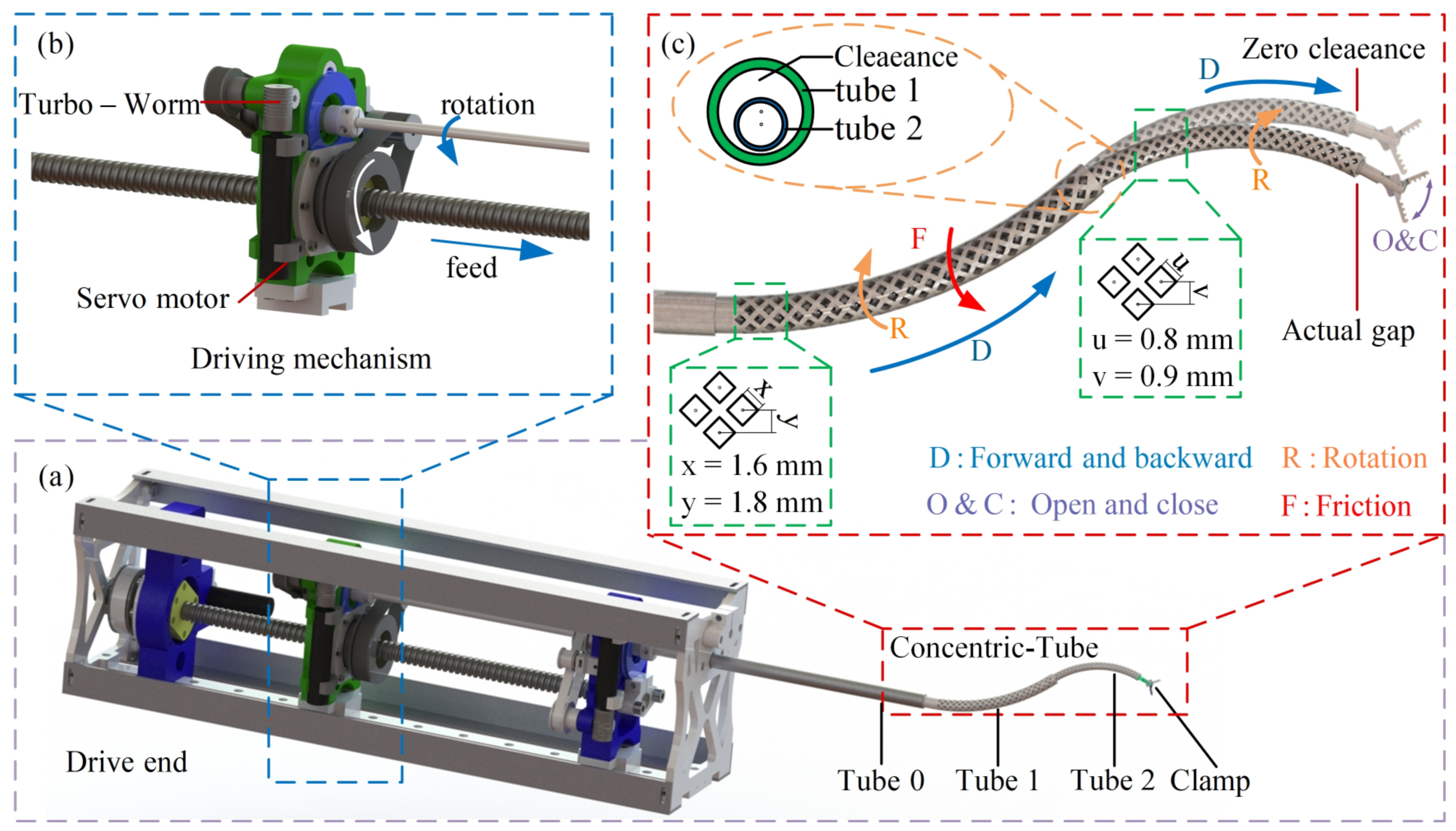
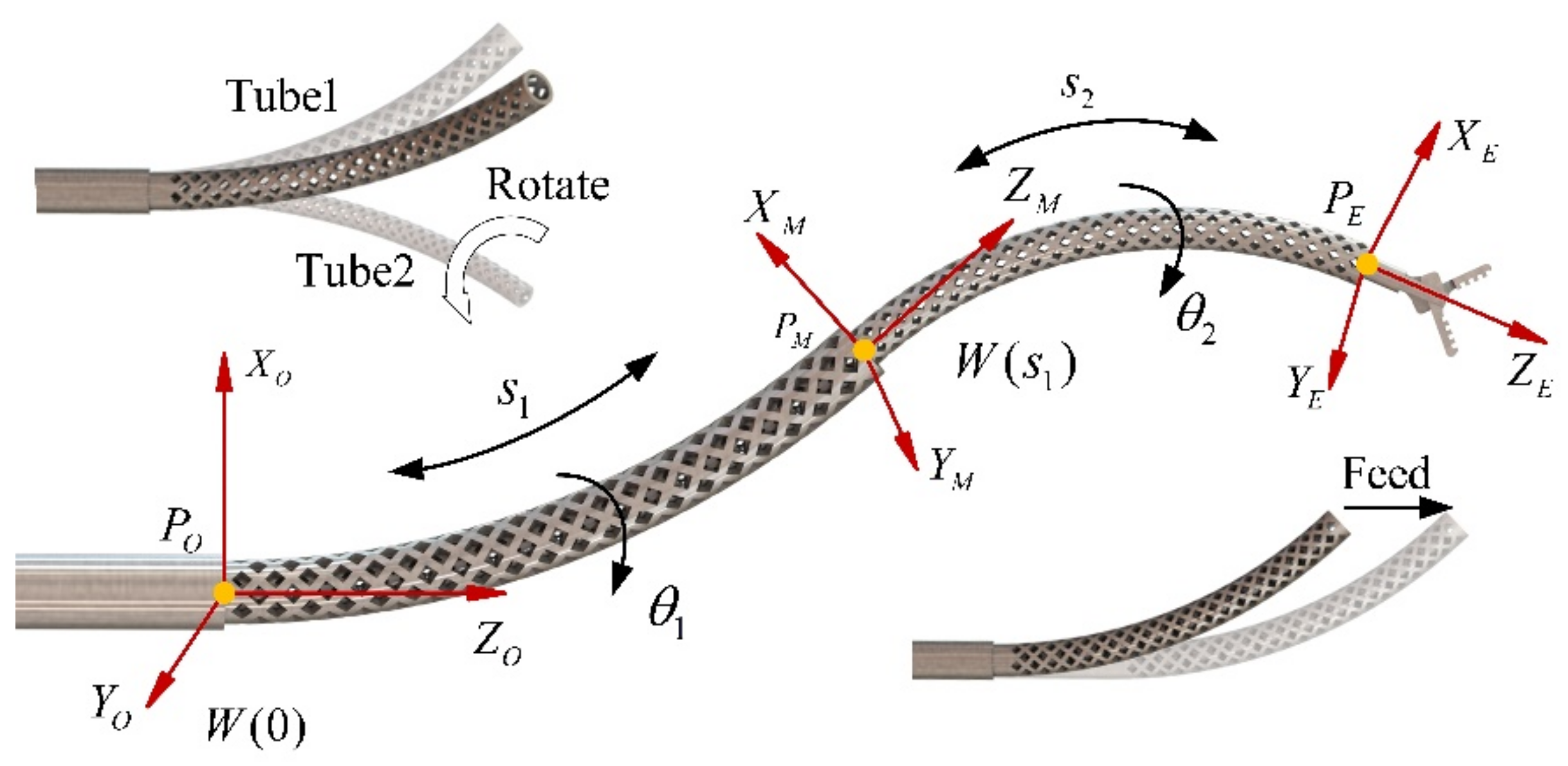
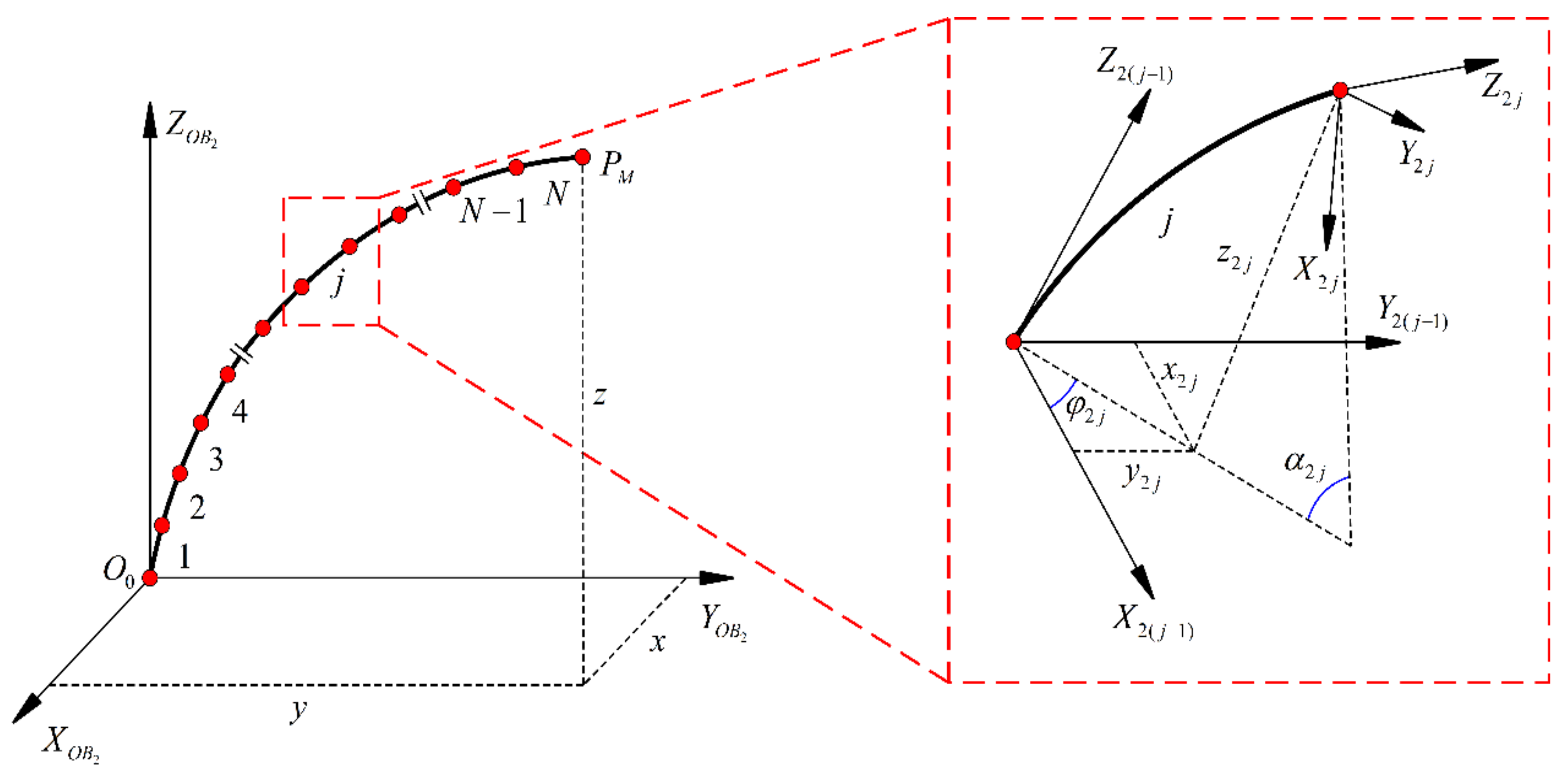
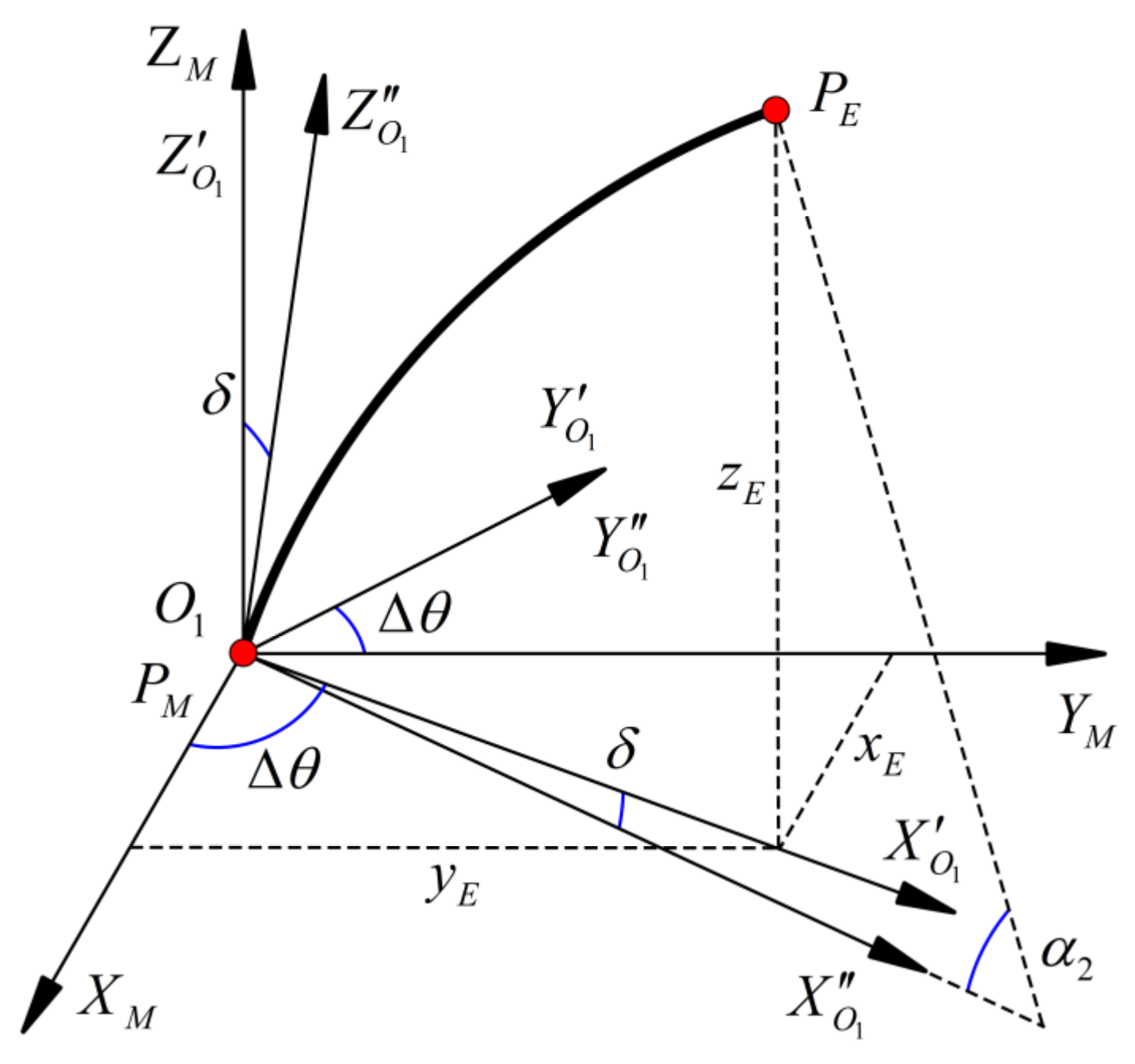


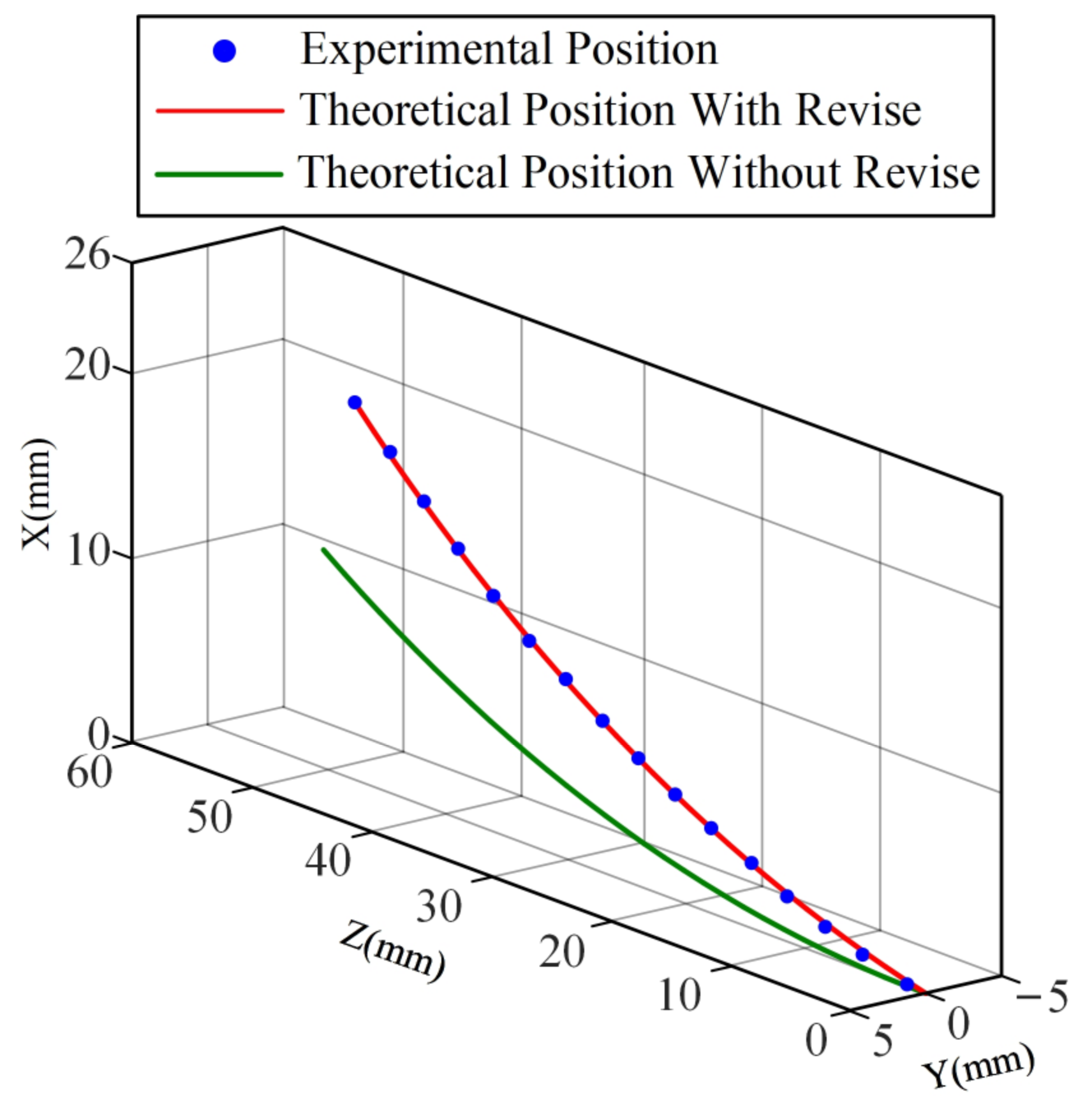
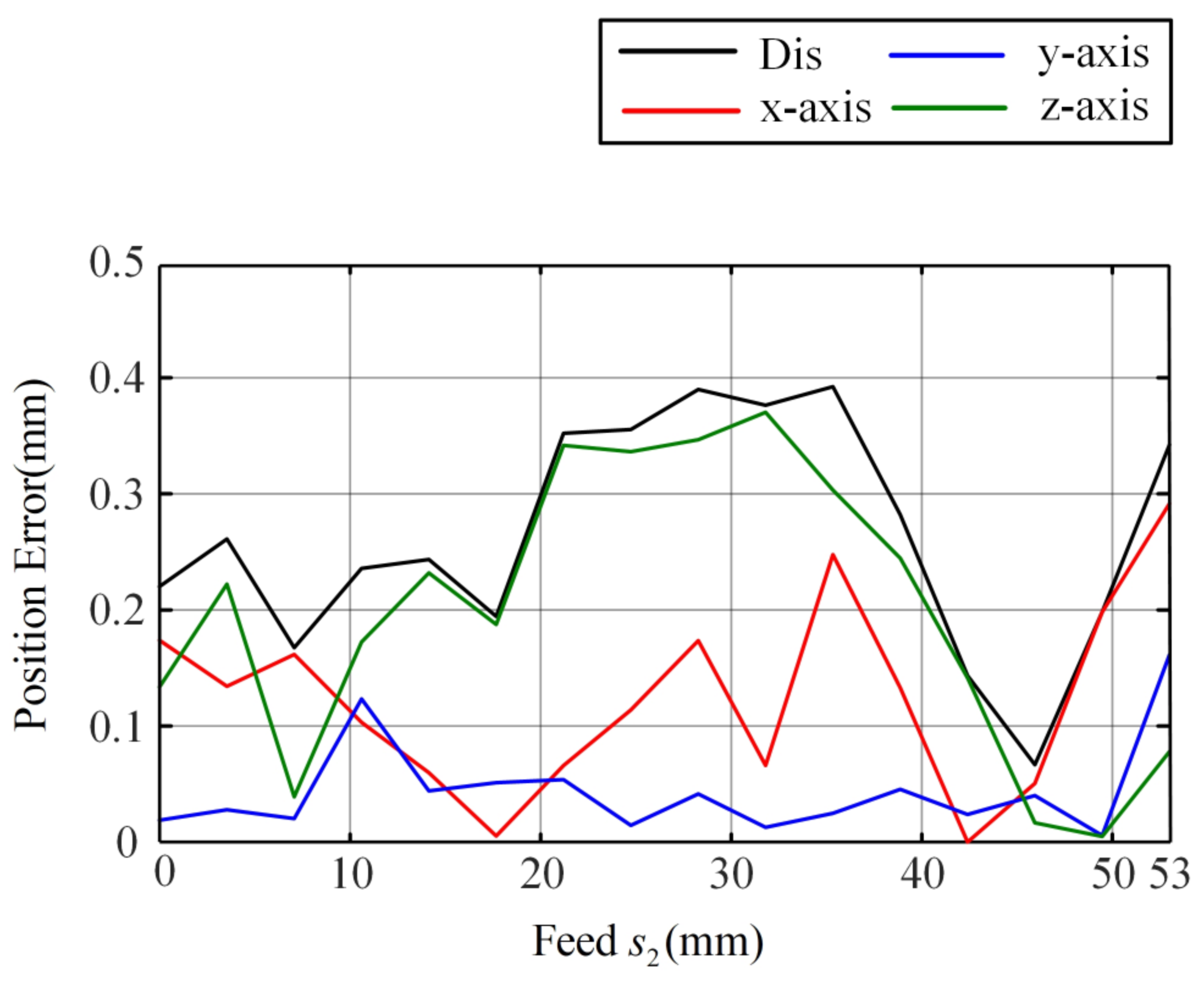
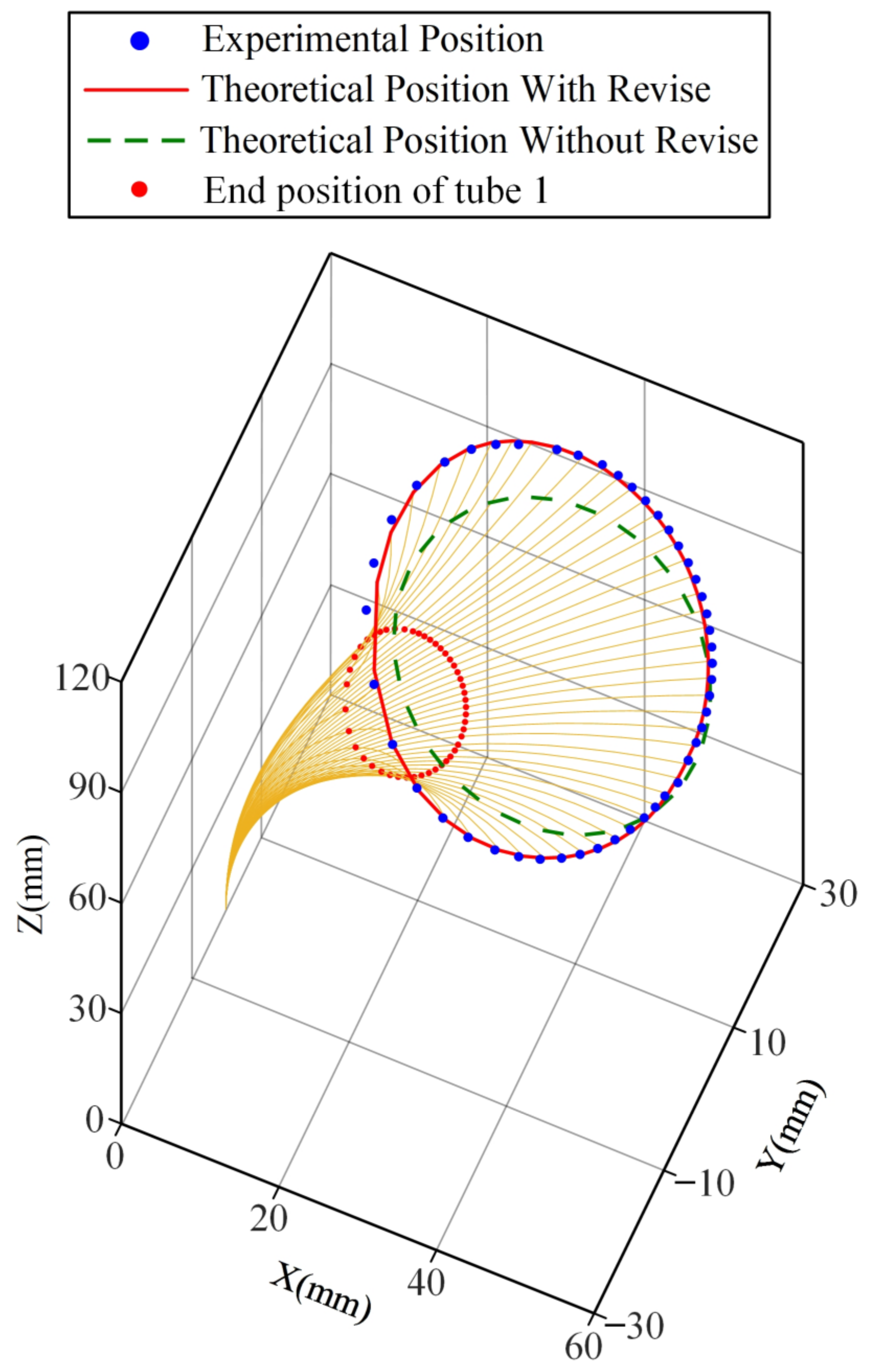
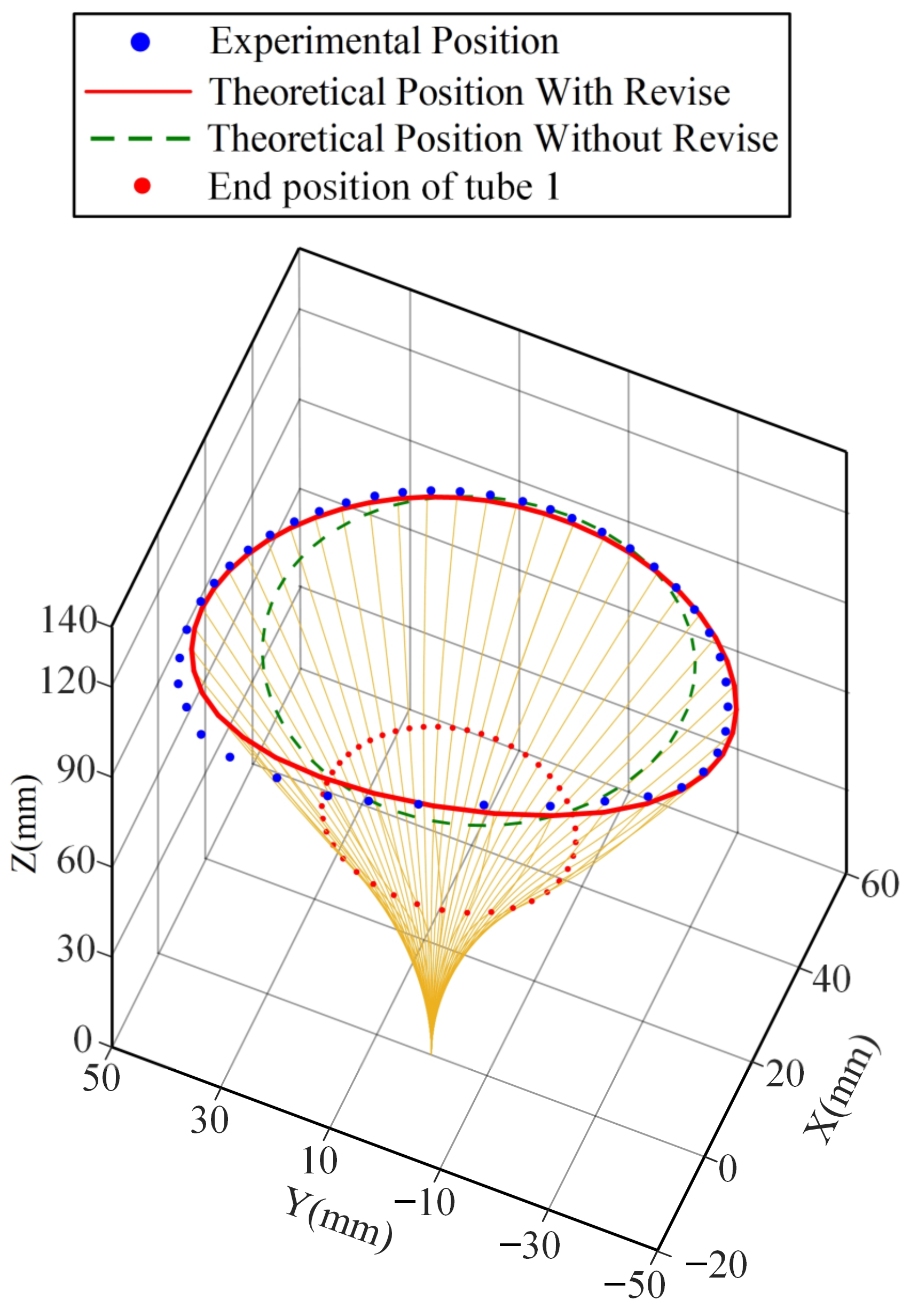


| Design Parameters | Outer Diameter/mm | Inner Diameter/mm | Radius of Curvature/mm | Total Arc Length/mm | Poisson’s Ratio |
|---|---|---|---|---|---|
| Tube 1 | 6.8 | 4.9 | 97 | 74 | 0.41 |
| Tube 2 | 4.5 | 2.7 | 98.5 | 114 | 0.41 |
| Experiment | Feed Motion | Rotational Motion (Inner Tube) | Rotational Motion (Outer Tube) |
|---|---|---|---|
| Average error (mm) (improved model) | 0.2 | 1.02 | 1.96 |
| Maximum error (mm) (improved model) | 0.39 | 2.6 | 4.5 |
| Average error (mm) (traditional model) | 4.95 | 4.2 | 6.7 |
| Maximum error (mm) (traditional model) | 9.7 | 5.9 | 12.1 |
Disclaimer/Publisher’s Note: The statements, opinions and data contained in all publications are solely those of the individual author(s) and contributor(s) and not of MDPI and/or the editor(s). MDPI and/or the editor(s) disclaim responsibility for any injury to people or property resulting from any ideas, methods, instructions or products referred to in the content. |
© 2023 by the authors. Licensee MDPI, Basel, Switzerland. This article is an open access article distributed under the terms and conditions of the Creative Commons Attribution (CC BY) license (https://creativecommons.org/licenses/by/4.0/).
Share and Cite
Liu, T.; Zhang, G.; Zhang, P.; Cheng, T.; Luo, Z.; Wang, S.; Du, F. Modeling of and Experimenting with Concentric Tube Robots: Considering Clearance, Friction and Torsion. Sensors 2023, 23, 3709. https://doi.org/10.3390/s23073709
Liu T, Zhang G, Zhang P, Cheng T, Luo Z, Wang S, Du F. Modeling of and Experimenting with Concentric Tube Robots: Considering Clearance, Friction and Torsion. Sensors. 2023; 23(7):3709. https://doi.org/10.3390/s23073709
Chicago/Turabian StyleLiu, Tianxiang, Gang Zhang, Peng Zhang, Tianyu Cheng, Zijie Luo, Shengsong Wang, and Fuxin Du. 2023. "Modeling of and Experimenting with Concentric Tube Robots: Considering Clearance, Friction and Torsion" Sensors 23, no. 7: 3709. https://doi.org/10.3390/s23073709





